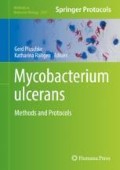Abstract
Mycolactones are a family of polyketide synthase products made by the human pathogen Mycobacterium ulcerans that were recently identified as novel inhibitors of the host membrane translocation complex (Sec61). Here, we provide protocols for the purification of mycolactones from bacterial cultures, and for their quantitative assessment in biological samples.
Access this chapter
Tax calculation will be finalised at checkout
Purchases are for personal use only
References
George KM, Chatterjee D, Gunawardana G et al (1999) Mycolactone: a polyketide toxin from mycobacterium ulcerans required for virulence. Science 283:854–857
Guenin-Macé L, Ruf M-T, Pluschke G, Demangel C (2019) Mycolactone: more than just a cytotoxin. In: Pluschke G, Röltgen K (eds) Buruli ulcer: mycobacterium ulcerans disease. Springer International Publishing, Cham, pp 117–134
Gehringer M, Altmann K-H (2017) The chemistry and biology of mycolactones. Beilstein J Org Chem 13:1596–1660. https://doi.org/10.3762/bjoc.13.159
Hong H, Demangel C, Pidot SJ et al (2008) Mycolactones: immunosuppressive and cytotoxic polyketides produced by aquatic mycobacteria. Nat Prod Rep 25:447–454. https://doi.org/10.1039/b803101k
Doig KD, Holt KE, Fyfe JAM et al (2012) On the origin of mycobacterium ulcerans, the causative agent of Buruli ulcer. BMC Genomics 13:258. https://doi.org/10.1186/1471-2164-13-258
Scherr N, Gersbach P, Dangy JP et al (2013) Structure-activity relationship studies on the macrolide exotoxin mycolactone of mycobacterium ulcerans. PLoS Negl Trop Dis 7:e2143. https://doi.org/10.1371/journal.pntd.0002143
Mve-Obiang A, Lee RE, Portaels F, Small PLC (2003) Heterogeneity of mycolactones produced by clinical isolates of mycobacterium ulcerans: implications for virulence. Infect Immun 71:774–783. https://doi.org/10.1128/iai.71.2.774-783.2003
Hong H, Stinear T, Porter J et al (2007) A novel mycolactone toxin obtained by biosynthetic engineering. Chembiochem 8:2043–2047. https://doi.org/10.1002/cbic.200700411
Baron L, Paatero AO, Morel JD et al (2016) Mycolactone subverts immunity by selectively blocking the Sec61 translocon. J Exp Med 213:2885–2896. https://doi.org/10.1084/jem.20160662
Demangel C, High S (2018) Sec61 blockade by mycolactone: a central mechanism in Buruli ulcer disease. Biol Cell 110:237–248. https://doi.org/10.1111/boc.201800030
Sarfo FS, Le Chevalier F, Aka N et al (2011) Mycolactone diffuses into the peripheral blood of Buruli ulcer patients--implications for diagnosis and disease monitoring. PLoS Negl Trop Dis 5:e1237. https://doi.org/10.1371/journal.pntd.0001237
Sarfo FS, Phillips RO, Zhang J et al (2014) Kinetics of mycolactone in human subcutaneous tissue during antibiotic therapy for mycobacterium ulcerans disease. BMC Infect Dis 14:202. https://doi.org/10.1186/1471-2334-14-202
Folch J, Lees M, Sloane Stanley GH (1957) A simple method for the isolation and purification of total lipides from animal tissues. J Biol Chem 226:497–509
Saint-Auret S, Abdelkafi H, Le Nouen D et al (2017) Modular total syntheses of mycolactone A/B and its [2H]-isotopologue. Org Biomol Chem 15:7518–7522. https://doi.org/10.1039/c7ob01943b
Marion E, Prado S, Cano C et al (2012) Photodegradation of the mycobacterium ulcerans toxin, mycolactones: considerations for handling and storage. PLoS One 7:e33600. https://doi.org/10.1371/journal.pone.0033600
Spangenberg T, Kishi Y (2010) Highly sensitive, operationally simple, cost/time effective detection of the mycolactones from the human pathogen mycobacterium ulcerans. Chem Commun (Camb) 46:1410–1412. https://doi.org/10.1039/b924896j
Kubicek-Sutherland JZ, Vu DM, Anderson AS et al (2019) Understanding the significance of biochemistry in the storage, handling, purification, and sampling of amphiphilic mycolactone. Toxins (Basel) 11:202. https://doi.org/10.3390/toxins11040202
Hong H, Gates PJ, Staunton J et al (2003) Identification using LC-MSn of co-metabolites in the biosynthesis of the polyketide toxin mycolactone by a clinical isolate of mycobacterium ulcerans. Chem Commun (Camb):2822–2823. https://doi.org/10.1039/b308163j
Author information
Authors and Affiliations
Corresponding author
Editor information
Editors and Affiliations
Rights and permissions
Copyright information
© 2022 The Author(s), under exclusive license to Springer Science+Business Media, LLC, part of Springer Nature
About this protocol
Cite this protocol
Rifflet, A., Demangel, C., Guenin-Macé, L. (2022). Mycolactone Purification from M. ulcerans Cultures and HPLC-Based Approaches for Mycolactone Quantification in Biological Samples. In: Pluschke, G., Röltgen, K. (eds) Mycobacterium ulcerans. Methods in Molecular Biology, vol 2387. Humana, New York, NY. https://doi.org/10.1007/978-1-0716-1779-3_13
Download citation
DOI: https://doi.org/10.1007/978-1-0716-1779-3_13
Published:
Publisher Name: Humana, New York, NY
Print ISBN: 978-1-0716-1778-6
Online ISBN: 978-1-0716-1779-3
eBook Packages: Springer Protocols

